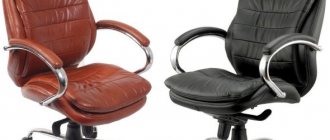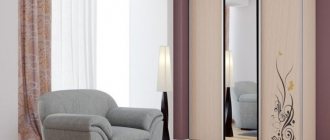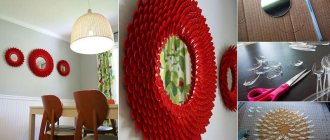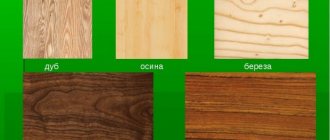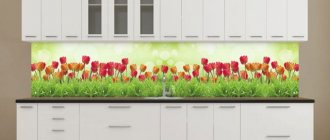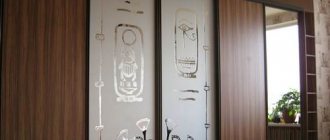Sometimes things happen that make a mirror on a closet, for one reason or another, need to be removed and replaced to avoid trouble. If a chip has formed on it, hopelessly spoiling the appearance, or a crack, it is better not to keep such a thing in the house and try to replace it with a new one as soon as possible.
In such a situation, your mirror not only spoils the appearance of the interior, but also becomes a direct threat to the residents, especially if there are small children in the house who are fond of active games. You can get rid of a cabinet decor element that has become superfluous in several ways, depending on the fastening, and the main tool is you and your hands. Our article is about how to peel off a mirror from a cabinet, remove it from a wall, or separate it from a wardrobe door if it was glued with liquid nails, double-sided tape or other glue.
If you do everything correctly, you will easily cope and will not spend a day waiting for a specialist and, most importantly, money.
Is it possible to peel off an extra decorative element yourself?
The answer is clear: yes. But for beginners, the process is quite labor-intensive and requires high concentration and careful attention, so it is better to arrange for yourself an environment in which nothing can distract you.
If you follow all the rules, follow safety precautions and follow the recommendations, you can remove the mirror at home in half an hour or less , but in cases of difficulties or complex fasteners, it is better to contact specialists with experience in such work with this issue.
Tips on how to easily and safely remove a mirror from a cabinet door
Of course, if you adhere to the rules and instructions described above, then the whole process will go through without any difficulties. However, you should also consider tips that will certainly make this work easier.
- When cutting drywall, it is advisable to make the edges even. This will make your future work much easier when you restore the surface or make repairs.
- When you cut through the glue, you should hold the mirror. You can even call another person to help you perform this function.
- To eliminate residues that are located at the site of the removed product, it is recommended to use a solvent. He will do an excellent job with this task. It is better to use this method in cases where further interaction with the element is planned.
- Remember that during the dismantling process all actions must be smooth and proceed carefully. Sudden movement is prohibited.
- When using the ruler, it is not recommended to raise it high, otherwise the mirror may break.
Now removing the mirror from the cabinet door will not be difficult for you.
Subscribe to our Social networks
What is the best way to disconnect?
- The first method is suitable for cabinets from which the door can be removed. Do not remove the mirror when it is in a vertical position, as you may break it and injure yourself.
- For the second method, you will need wire, and it works like this: with movements to the left and right, you need to cut off both the layer of liquid nails and other adhesive mass that attaches your mirror to the cabinet. This option is very convenient and the safest: nothing will burst or crack if you do not overdo it with sharp movements.
- The third method is intended for a wardrobe, when working with which it is especially recommended to be more careful and adjust the level of brute force if the mirror is not to be damaged.
Criteria for high-quality glue for mirrors
Experts recommend buying an adhesive base that has the inscription “for mirrors” on it. A universal one does not live up to expectations, will take time, and will ruin the surface of the mirror. Manufacturers try to add different chemicals to reduce the cost of the product. When purchasing a product, you need to know its quality criteria:
- Study the composition carefully. It should not contain alkali or acids.
- Should not harm the mirror coating.
- The pH level in the composition should be suitable for glass.
- The addition of cheap chemical compounds contributes to the creation of a strong, suffocating odor. A quality product does not have a strong odor.
- Application allows you to achieve reliable fixation with glass.
- The color must be white or transparent.
Step-by-step guide on how to remove unwanted surface
Method number one:
- Using a screwdriver, remove the cabinet element on which the mirror to be removed is attached, holding it and twisting the fasteners.
- Place the door on a horizontal surface that is most comfortable to work on.
- Take a metal ruler and sharpen it at the narrow end using sandpaper - this will be the main thing.
- Cover the mirror with tape so that the fragments do not fly to the sides and into your eyes, this way there will be less debris around.
Important: the more free space, the less likely it is to make a mistake.
- Insert the sharp end between the mirror and the door and start tapping the opposite end of the ruler with a hammer, gradually driving it deeper with light blows and peeling off the mirror.
Do not overdo it! Do not lift the ruler too high and tap it carefully so that the mirror does not crack. - Carefully remove the mirror separated from the door and remove the fragments if it breaks.
Method number two:
- Take the cutting wire and unwind it, tying a wooden block to each end to make it comfortable to hold your tool and prevent the possibility of cutting your fingers.
- Start by wrapping the wire around the edge of the mirror and “filing” it, moving from one corner to the other.
- Slowly pass it between the mirror and the surface. The threaded and moving wire will cut off the glue on which the mirror is attached.
- It is advisable to involve a second person in the work who will hold the mirror so that it does not fall or break if you are working in a vertical position. The safest thing to do is remove the door.
Method number three:
- Take the tape and start covering the front side of the mirror.
- Slide the chisel under the mirror surface and gently press, starting to separate it from the door.
- Since the mirror may burst, after work you should collect the fragments in a bag.
Features of cleaning marks depending on the type of surface
Before you begin to deal with tape residues, you should consider which method will be not only more effective, but also the safest and most gentle. It can be different for each type of surface.
Glass, mirror
Any removal method will do, except using abrasives or metal brushes , since it is not difficult to scratch the glass surface:
The heating is allowed to be low, so a hair dryer will not work here. Otherwise, the glass product will simply crack.- You can use oil, alcohol, solvents or glass cleaners.
- Baking soda, which is a weak abrasive, and a school eraser will not leave visible marks on the glass or mirror.
- Paper tape can be soaked in hot water in advance to remove the top paper layer.
You can learn more about ways to remove tape residue from glass here.
Plastic
It is even easier to damage than glass, so no brushes or scrapers . Products made from polymers should also not be heated - some types of plastic may lose their shape and warp at elevated temperatures.
Find out more about removing tape marks from plastic surfaces here.
Tree
When transporting furniture, adhesive tape is used quite often. After all, it is so convenient to fix doors that are trying to open. But then the torment comes. It seems that the tape is firmly stuck to the smooth surface.
How to remove from a wooden surface:
Both polished and unvarnished wood is quite capricious. The heating method will not work here.
The varnish will crack when exposed to high temperatures. In this case, there is no need to use active chemical reagents and solvents.
Read more about how to clean tape and its residues from furniture in this article.
Laminate
Even a coating with a high wear resistance class can be damaged by an overly sharp blade. Scratching a regular laminated panel with a knife is even easier. Therefore, no knives .
Treating the surface with a solvent to avoid removing the polymer coating is also prohibited.
Since laminate does not tolerate large amounts of water, this is done with a slightly damp cloth,
Painted or wallpapered walls
Removing tape from such a surface is most problematic. It will be removed along with paper, acrylic or water-based emulsion. It is especially difficult to remove it from non-uniform, uneven surfaces.
First, the glue is softened with an iron: it should be warm, but not hot . Iron the problem area through gauze or a thin napkin. The softened tape will come off easily.
How to cut or tear off a mirror panel glued with double-sided tape from a door?
Double-sided tape does not seem as impressive as liquid nails, but this is not entirely true, because the mirror can be glued to it not only in the middle and along the edges, but also over the entire area. If desired, the mirror can be torn away from its mounting location, but there is a high risk of breaking the thing and injuring your hands with large fragments, so it is better to discard this method immediately and not try to use it under any circumstances.
A good way to remove a mirror from double-sided tape is similar to the one described above using cutting wire. If you don’t have an item for exactly this purpose, you can take a strong string or any thin but strong wire that will pass between the mirror and the door and will not break during the sawing process.
Petrovich's Personal Blog
I would like to share how I peeled off a mirror from a closet door.
I apologize that there are no illustrations, I didn’t think to take a photo at that moment, but I also can’t help but tell you about it, since at the moment I haven’t found anything other than the string method on the net. I once watched a video of how they removed a mirror from a door with the help of a string at an accelerated speed. My method turned out faster than the video on accelerated recording. So let's start to figure it out.
The mirror is usually glued to three stripes, along the edges and one in the middle. Cutting all three with a string is difficult and time-consuming, so I cut off the side strips with a blade from a hacksaw (by the way, I tried it with an ordinary wallpaper knife, it also cuts great)
All that remains is to cut off one central strip, I used a meter-long metal ruler, simply put it behind the mirror and pulled it down with both hands.
I really don’t know if this method will work if the mirror is glued to liquid nails.
How to remove marks on the wall after dismantling?
Once the mirror has been removed, you can begin to peel off the old adhesive layer . You can do this in the usual way, using a spatula or knife, if this place then covers the mirror again. To preserve the surface and not scratch it, you can use the second option: here the main assistant is gasoline or solvent.
The solution with dissolution is more successful if there is information about the composition of the glue. You need to apply a solvent to the surface of the cabinet and wait until it softens the glue and allows it to be wiped off. You can stick a new mirror onto the cleaned area, but this must be done carefully so as not to break it.
How to remove?
Before you begin removing double-sided tape, you must carefully read the instructions and removal tips, because any careless movement can ruin the surface on which traces of the tape are located.
There are dozens, maybe hundreds of methods for removing adhesive marks, but the most effective ones are revealed below. Let's look at each of them in more detail.
Stationery knife
The method is simple, but it is permissible to use it if the likelihood of scratching the surface is minimal . Proceed with caution.
The paper or film base is pryed off with a blade. The loose edge of the tape can be easily torn off by hand.
If it was not possible to remove all the adhesive tape at once, and pieces remain, you need to lift the edge of the adhesive tape again with the tip of a knife, and so on until it is completely removed.
Rubber (caoutchouc) disc
A soft attachment for a drill or screwdriver will help you cut off adhesive tape from a large area . The rubber disc will remove the top sticky layer without leaving scratches on the surface.
The tool must be set to minimum speed. Plastic rubber will not harm even the paintwork.
Glue heated to 80-100°C is removed faster. You can use either a hair dryer or a hair dryer to dry your hair. They can be replaced with an iron set to the minimum temperature.
The advantage of this method is the absence of scratches even on paper . The most tightly attached tape can be removed without difficulty.
But there is no need to heat non-heat-resistant objects to high temperatures, especially with a powerful hair dryer - they will immediately deform. It is better to expose them to the sun for a short time or keep them under steam - the glue will noticeably soften.
Oil
The glue will easily slide off if you lubricate the area of contamination with vegetable or essential (for example, eucalyptus) oil . They contain organic unsaturated acids that can dilute polymers:
Wipe the sticky surface with a sponge and leave for several hours.- You can lay a rag soaked in oil on a horizontal tabletop or bedside table for about 20 minutes.
- If the stain is stubborn, it is best to leave the greased stain on overnight. In the morning the stain will come off without effort.
- All that remains is to wash off the oil. Easy to clean surfaces (glass, polished furniture, plastic) do not absorb grease, so there will be no problems.
This method is not acceptable for paper wallpaper.
Eraser
If you rub the remaining glue with a regular eraser, it will form pellets and come off easily . Just rub it with a cloth.
Gasoline, acetone, white spirit
The main advantage of the method is the ease and speed of removal:
It is necessary to moisten a rag in any of the existing types of solvents and rub the stain.
It is better to replace it with a highly purified composition, for example, liquid intended for refilling Zippo lighters.
Glass cleaning liquid
Most of them are made with alcohol, which is an excellent solvent.:
- You need to rub the stain with a sponge or rag soaked in this mixture, and after a couple of minutes there will be no trace of the sticky stain.
- You can replace the windshield wiper with regular drinking alcohol or ammonia. They can even cope with dried out, old stains.
- More serious products are car glass cleaners. But it should be noted that, in addition to alcohol, they contain quite strong chemicals and ammonia.
Table vinegar or citric acid
Any acid can dissolve glue . In everyday life, vinegar or lemon is more often used.
You should rub the contaminated area with citric acid soaked in table vinegar or diluted water, and the dirt will easily come off.
This method has a significant advantage: the acid does not leave streaks . The smell of vinegar will disappear in just half an hour.
Safety rules at work
- The first and most important rule is to cover your body with clothing so that if something happens, the fragments do not cut your skin.
- The second rule is to work in an open place, preferably on the street. If this is not possible, it is necessary to thoroughly clean the room in which all work will be carried out, and to prevent any residue in the form of small fragments on the floor.
- The third rule is not to allow children to approach the tools or touch the door with the mirror, as the child may accidentally push it off or cut himself.
- The fourth rule is to regularly check your hands for small fragments and stop working if you notice that fragments have gotten into them.
- The fifth rule is that it is advisable to work in protective glasses so as not to injure yourself.
Removing mirrors at home is an activity that requires patience and the ability to take your time, as well as increased safety in working conditions. If you are not sure that you have sufficient skills for dismantling, and you do not know whether you can do it yourself, it is better not to tempt fate and call a specialist, paying, but saving your nerves and health.
However, using the methods described above and taking into account safety precautions, you can do it yourself in a short time, without losing money, which you will certainly succeed with the step-by-step help provided.
